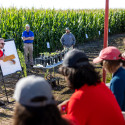When the subject you study saves your life
What’s it like when a scientist who studies stem cells becomes a patient who receives them to save his life?
Kurt Saupe, an associate professor of medicine, recently learned that he received a federal stimulus grant of $107,195 over 11 months to continue his studies of calorie restriction’s impact on the stem cells that occur naturally in both heart tissue and fat tissue and help repair damage to the heart.
But as exciting as that news was, he has an even more personal relationship with another type of stem cell.
In December 2007, Saupe, then 46, was suddenly so out of breath he couldn’t keep up with his teammates at his regular noon-hour soccer game at the McClain Center. During the Christmas holidays, his wife, Nancy Sweitzer, a UW Health cardiologist, insisted he go to urgent care.
There, the resident recognized Saupe as his first-year physiology professor. “He pronounced my name right, which never happens,” says Saupe, a Madison native whose name rhymes with “copy.”
A chest X-ray showed Saupe had a collapsed lung due to a buildup of fluid in his chest, and analysis of this fluid brought even more grim news: acute lymphoblastic leukemia. The disease most often occurs in children, where it has a high cure rate. But the prognosis is dire for an adult: just 25 percent of them live five years after their diagnosis.
Saupe soon learned that his best chance was a stem-cell transplant. The International Bone Marrow Registry matched him with a woman donor in Germany. He underwent chemo and radiation therapy in May 2008 to wipe out his own immune system. Then he received stem cells harvested from the donor after she got an injection that made her bone marrow release stem cells into her blood stream; newer methods make stem cell donation more like giving blood than the gruesome bone drilling of the past.
The transplant is a success. Laboratory tests show that Saupe’s immune system is now female; his blood cells carry the XX chromosome pattern of a woman. And, yes, he has had plenty of teasing from his soccer pals about that.
“Overall, the experience taught me how difficult and complex it is to be a patient,’’ Saupe says. “The more knowledge you have, the better.”
He credits his oncologist, Natalie Callander, and his wife, who treats heart failure patients who undergo transplants, with advising him on the many anti-rejection drugs he now takes. He still struggles with health issues as a result of the chemo and transplant, but says his wife warned him, “When you have a transplant you trade in one set of problems for another.”
He also has a new appreciation for bone-marrow donors. And while he isn’t back into soccer shape, this past summer, Saupe appeared at a Madison Mallards game benefiting the Restoring Hope, a Middleton house for transplant patients. He says the couple’s children, Peter, 8, and Geneva, 10, loved that experience.
“They could care less that I got tenure,” Saupe says, “but they thought throwing out the first pitch was really cool.”




